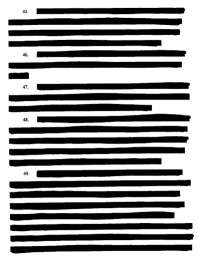Censor bars
Censor bars are a basic form of text, photography, and video censorship in which "sensitive" information or images are occluded by black, gray, or even white rectangular boxes. These bars have been used to censor various parts of images.[1][2] Since the creation of digital editing software which can apply less obtrusive effects such as pixelization and blurring, censor bars are typically used for satire,[3][4] although they remain in contemporary use to address privacy concerns.
Illustrations of usage
.png) A 1965 FBI surveillance photograph
A 1965 FBI surveillance photograph A heavily redacted page from the lawsuit American Civil Liberties Union v. Ashcroft
A heavily redacted page from the lawsuit American Civil Liberties Union v. Ashcroft
.jpg) Censor bars applied to an academy painting
Censor bars applied to an academy painting Censor bars applied to a model
Censor bars applied to a model Censor bars applied to a patient with Stevens–Johnson syndrome
Censor bars applied to a patient with Stevens–Johnson syndrome A female Ashkenazi Jew with familial dysautonomia.
A female Ashkenazi Jew with familial dysautonomia. The Turkish Wikipedia logo with a censor bar above the text. This version of the logo has been in use since Turkish authorities blocked online access to Wikipedia in all languages across Turkey.
The Turkish Wikipedia logo with a censor bar above the text. This version of the logo has been in use since Turkish authorities blocked online access to Wikipedia in all languages across Turkey.
gollark: I once accidentally chiseled a 10x10x10 block area into chiseled stone, and hi.#
gollark: The Apple iChisel has nice features like being to chisel ridiculous areas at once.
gollark: Who hath pingéd me?
gollark: Yes, so you don't need flagships.
gollark: The only difference is going to be higher res screens, and slightly better processors.
References
- The Purple Decades: A Reader, Tom Wolfe, p. 78
- Context Providers: Conditions of Meaning in Media Arts, Margot Lovejoy & Christiane Paul & Victoria Vesna
- Banned in the media: a reference guide to censorship in the press, motion pictures, broadcasting, and the internet, Herbert N. Foerstel, p. 208
- Click: The Forces Behind How We Fully Engage with People, Work, and Everything We Do, Ori Brafman & Rom Brafman, p.108
External links
This article is issued from Wikipedia. The text is licensed under Creative Commons - Attribution - Sharealike. Additional terms may apply for the media files.
